Information or Inspiration? 左脳と右脳でたのしむ日本の美
information or inspiration?
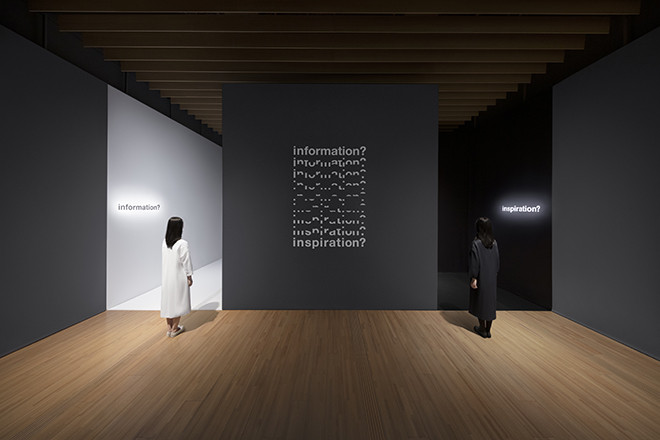






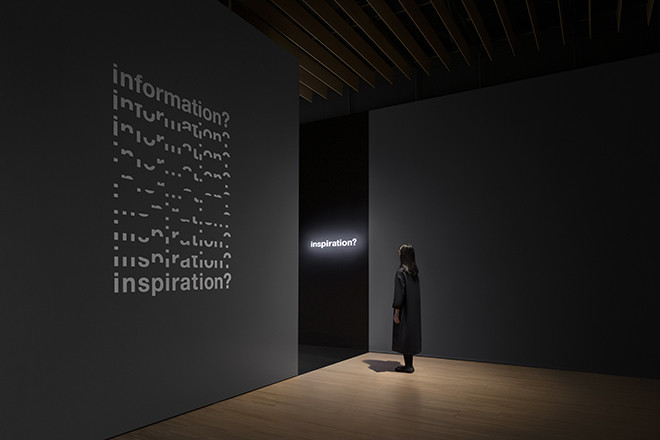






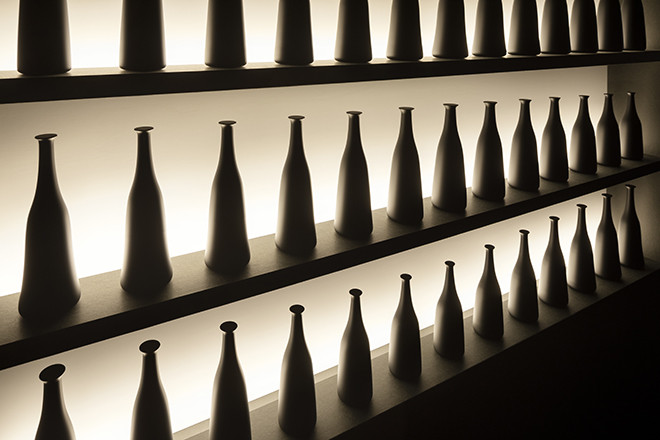











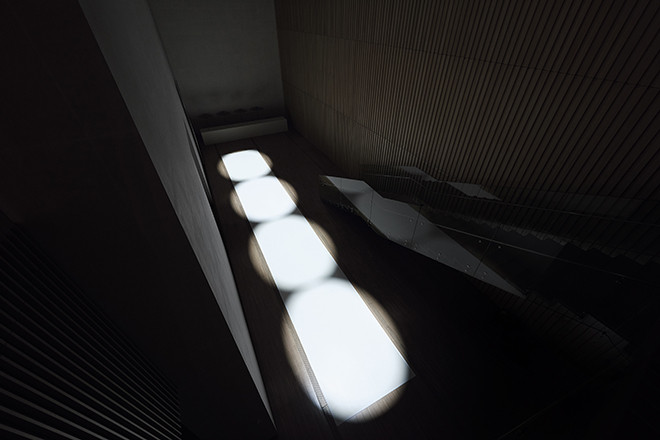
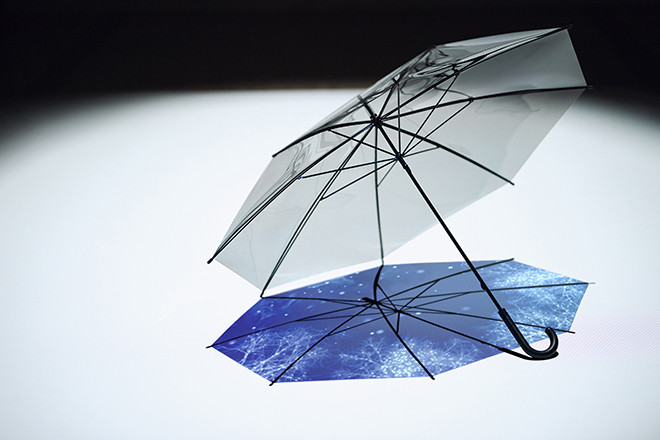





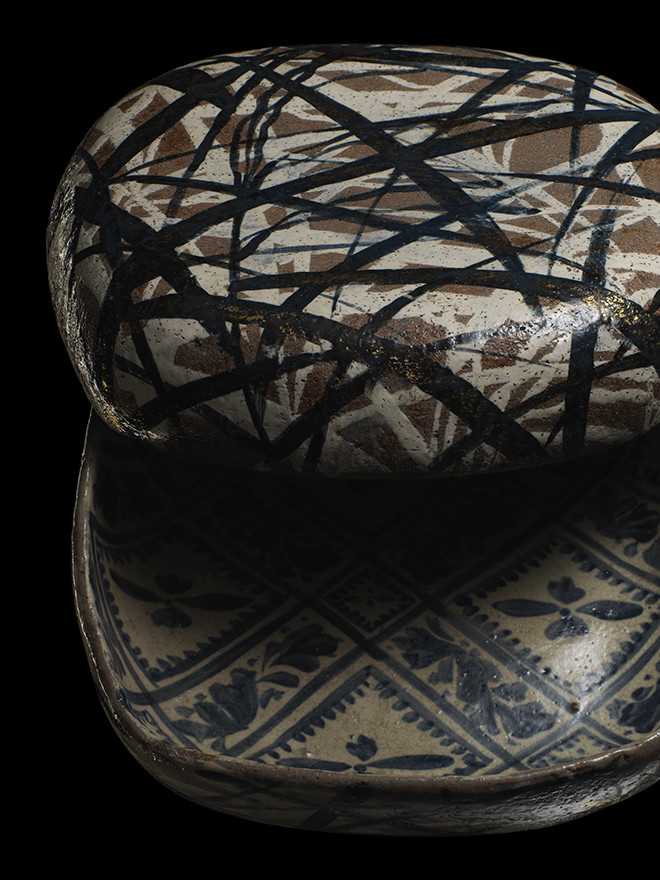





デザインオフィス nendo に空間デザイン協力した展覧会「Information or Inspiration? 左脳と右脳でたのしむ日本の美」六本木の東京ミッドタウン内にあるサントリー美術館で開催された、日本美術を紹介する展覧会の企画と展示デザイン。
鑑賞者が美術作品を前にしたときに、その作品の背景にある製作過程や、作者の意図や想いなどを知ることで生まれる感動と、ただただ理由もなく心が揺さぶられる感動という、2種類の感動があると仮定。前者を「information(左脳的感動)」、後者を「inspiration(右脳的感動)」と位置づけ、同一の作品に対して2つの異なる鑑賞の仕方を提案することを考えた。「information」が作品を解説する文字情報が豊富なのに対し、「inspiration」は解説文は一切無く、作品の一部のみをフィーチャーした「偏った」見せ方をすることで、
日本美術に馴染みの薄い鑑賞者でも直感的にその魅力を感じ取ってもらえることを目指した。このコンセプトに沿って、サントリー美術館が所蔵する日本美術作品約3,000件の中から27点を選定。次に、展示空間を「information」と「inspiration」の2つに分断し、その狭間に作品を配置することで「1つの展覧会のようで2つの楽しみかたができる」展覧会となった。
「information」が真っ白な空間なのに対して「inspiration」は真っ黒に仕上げ、切子のガラス工芸品は器自体ではなく、ガラスを透過して周囲に浮かび上がる光の陰影を展示。「熟柿」と呼ばれる赤楽茶碗は、裏から見ると「柿」のように見えることから、鏡を使って底面のみが楽しめるように。また、根来塗の瓶子は、赤いフィルター越しに眺めることで、表面の朱漆が摩滅して下地の黒漆が部分的に露出している美しさを際立たせたいと考えた。「蓮下絵百人一首和歌巻断簡」などの平面作品は、異なる種類の和紙が継ぎ足されて作られている様子を表現するために、同様に複数色の和紙をつなぎ合わせたオブジェ越しに展示をしたり、「蔦下絵新古今集和歌色紙」は透明アクリル製のオブジェを使って各要素を分解して見せたりすることで、下絵と書の関係性の面白さを体感できるようにした。それ以外にも、「菊蒔絵煙草盆」は、その機能を示す「灰皿・タバコ・ライター」を並べて展示することで現代の日常性と対比させ、それぞれわずかに形状が異なる宙吹きで作られた3つのガラス製の徳利は、その「不完全な量産製品」としての面白さを浮かび上がらせるために、3Dプリンターを用いた「意図的に不完全な単品生産品」と対比させた。「白泥染付金彩薄文蓋物」は蓋を開いたときの驚きを体感できるように、上空に「蓋」のような小空間を用意して、鑑賞者がその中に潜り込めるようにした。このような視覚のみに頼らない表現として他にも、香合や香炉といった香りにまつわる作品の付近には異なる香りを焚き、立体的なカットによって柄が表現されている薩摩切子を「触る」ことで感じ取れるような直径1500mmの半立体オブジェを用意した。展示室は4階と3階にまたがっており、その中間に位置する吹き抜け空間には、本展のために製作された映像作品「uncovered skies」を展示。日本美術とは切っても切れない「四季」をテーマにしたこの作品もまた、直感的に体感できる「inspiration」的な要素と、その製作過程や技術的な解説を楽しめる「information」的要素を兼ね備えている。
「information」と「inspiration」の順路は、どちらから先に鑑賞しても、片方だけ楽しんで帰っても良く、それによって展覧会の印象の個人差が大きくなり、鑑賞者同士のコミュニケーションが誘発されることを願った。オフィシャルブックも、まるで「1冊の本の中に2冊の本がある」情緒的な写真のみとなっている。本展は、決して左脳的な美意識と右脳的な美意識に優劣をつけることが目的ではなく、一度両者を意識的に切り離すことで、そこから抜け落ちた価値や、重複した要素、そして浮かび上がる多くの矛盾に気づくことに期待している。この、左脳と右脳の間に横たわる膨大なグレーゾーンの存在とその魅力を再認識することこそが、少々逆説的ながらも、本展の隠れたメッセージなのかもしれない。
会期:2019年4月27日〜6月2日
会場:サントリー美術館
クライアント:サントリーホールディングス株式会社
コラボレーション:有限会社nendo
インテリアデザイン:佐藤オオキ (有限会社nendo) 小栗誠詞 (株式会社イド)
写真 (01-09,11-18,20,22-25,29-33,35,37-39):太田拓実
写真 (10,19,21,26,34,36):岩崎寛
写真 (27,28):shuntaro (bird and insect ltd.)
id inc. is collaborating with the design office nendo, providing space design.
Curatorship and design for a traditional Japanese art exhibition commissioned by the Suntory Museum of Art located in the Tokyo Midtown complex at Tokyo’s Roppongi district.
Born from the idea of the left and right sides of the brain, the exhibition introduces a new concept of display where visitors can choose between two different and distinctive routes; “information” or “inspiration”. The first route focuses on the informative and contextual aspects of the artworks in display. With the use of text and graphic data next to the objects, curious visitors can learn about the ideas behind the creative process and the artists’ intentions. The “inspiration” route suggests a more vague and minimal approach in which visitors can have a personal and maybe even emotional experience. In a darker dramatic setting, each object is presented in a way that captures its uniqueness. In this route the visitors can intuitively relate to the work without the use of words. Out of 3000 pieces from the permanent collection of the Suntory Museum of Art, 27 objects were carefully selected for the exhibition. The objects are placed in the centre of a custom-made display that is located right between the two routes, allowing each object to be viewed from both sides in two very different ways.
The “information” side, painted all white, shows the objects in a bright and traditional display, while the “inspiration” side, painted in black, showcases the objects in various ways, depending on the qualities of each individual object. After a comprehensive research process, it became possible to indicate the interesting and unique qualities of each object and accordingly design the specific display for each piece. For example, the traditional “Kiriko” glassware, unique for their delicate cutout patterns, are presented by showing the shadows of the objects, highlighting the textures rather than the objects themselves. The “Red Raku tea bowl, named Jukushi”, a unique Raku-ware tea bowl that has a base that is shaped like a persimmon, is presented with the use of a mirror that allows the visitors to notice only its special detail. The famous red Negoro lacquer technique is a layering method intended to gradually wear away with time and use, revealing the black lacquer under layer. The bottle that is painted with this technique in the exhibition is presented to the visitors behind a red filter. This effect eliminates the red tone of the lacquer and allows the object to appear in its slick black colour. The painting “Fragment of a Hyakunin Isshu (A hundred poets, ahundred poems)scroll on underpaintng of lotuses” is only a segment of an originally 25-meter long artwork created in the 17th century. The “inspiration” side reveals the unique process of creating this painting, displaying it as a part of an object made of several types of traditional Japanese paper. The painting “Poem from the Shin kokinshu (New poems ancient and modern) on underpainting of ivy” is presented in a decomposed layered array using transparent acrylic sheets in order to convey the multiple layers of drawing and calligraphy uniquely combined in this work. The “Smoking set with chrysthemum design in maki-e” is displayed with a modern ashtray, tobacco and lighter by its side, expressing to the viewers the contrast between our daily life in the past and in the present. Three glass-blown sake bottles that are slightly different than one another express the uniqueness of historical mass-production, where handmade objects were created without the use of molds. To best showcase this special quality in the “inspiration” side, a wall mounted installation was created, presenting identical replicas of the distorted bottles made ironically, with 3D printing technology, the ultimate single product production. A small space like “lid” welcome visitor to experience the surprise when opening the lid of “Hakudei Sometsuke Kinsai Susukimon Futamono.” The box “Covered box with silver grass design in underglaze blue, overglaze iron oxide, and gold” contains a surprising pattern when its lid is lifted. Therefore, in order to grant the visitors with the same excitement, they can enter a small space that replicates the same texture on its interior walls and ceiling, as if they were entering the box itself. In addition to the visual effects presented in the exhibition, other senses such as scent and touch were added to the experience; burning incense in proximity to a relevant object and manufacturing large-scale touchable reliefs for visitors to feel the textures they are viewing.
The exhibition spans across the fourth and third floors of the museum. Visitors can decide on their own journey through the space; they can start either from the “information” or the “inspiration” route, or can enjoy only one of them if they choose. The various ways to experience and walk through the exhibition will increase and encourage communication between visitors in the space. In the museum’s atrium in the middle of the space a new multimedia installation “uncovered skies” will be presented. The work features the four seasons, which are a significant part of Japanese culture and art. The installation also contains “inspiration” elements that can be experienced intuitively, and “information” elements that excite visitors to enjoy the production process and technical innovation.
The exhibition’s official book was designed to appear as if two separate books were combined to one; the “information” book contains text and data and the “inspiration” book consists of high-quality and detailed images. The concept behind the exhibition was not to determine the superiority between the two approaches. It was a conscious decision to separate the experience into two elements in order to refine their individual values. The recognition that there is an apparent “grey zone” lying between “information” and “inspiration” may be a paradoxical, hidden moral behind the exhibition.
DATE:Apr.27 - Jun.3, 2019
PLACE:SUNTORY MUSEUM of ART
CLIENT:Suntory Holdings Limited
INTERIOR DESIGN:Oki Sato (nendo) Seiji Oguri (id inc.)
PHOTOGRAPHS (01-09,11-18,20,22-25,29-33,35,37-39):Takumi Ota
PHOTOGRAPHS (10,19,21,26,34,36):Hiroshi Iwasaki
PHOTOGRAPHS (27,28):shuntaro (bird and insect ltd.)













